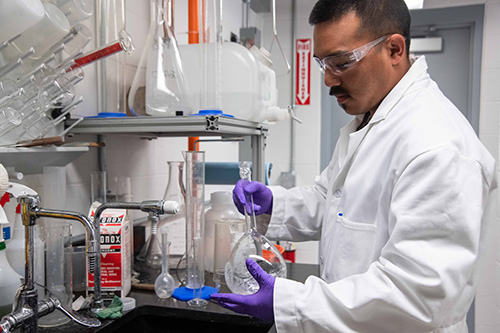In our first post on ferrous sulfate we covered its composition as well as practical uses. Understanding the nuts and bolts of this chemical is useful, but even more important is knowing about handling and storing ferrous sulfate safely.
General Safety Guidelines
General safety procedures should be followed when handling and storing ferrous sulfate. These include, for example (1):
- Store and label all chemical products in accordance with the instructions on the safety sheet. Chemicals must normally be stored in their original packaging. If you need smaller amounts of this chemical, the new packaging must be suitable for the substance.
- Do not store chemicals together with inflammable material and gas cylinders.
- Store chemical containers with closed lids when they are not in use.
- Equipment for handling and cleaning up spillage must be in readiness and suitable for the stored chemicals. In addition, it is suitable to have equipment placed outside the chemical store.
- It is important for the fire classification of storage lockers and rooms to match the types and amounts of chemicals stored therein.
- Store combustible material in fireproof cupboards or in separate spaces.
- Use personal protection equipment (e.g., gloves, face mask) where necessary.
- Handle surplus chemicals and hazardous waste in accordance with the information in the safety data sheet.
- Ensure First Aid equipment is readily available.
- Clean workplaces regularly. Moreover, there must not be chemical spills on the floor.

Human Risks of Ferrous Sulfate
Ferrous sulfate is useful in many applications, but you must take adequate precautions when handling it. Listed below is data on toxicology. (2)
Toxicology Information
Acute Toxicity Estimate: The acute oral LD50 is 132-881 mg Fe/kg (rat).
Chronic Toxicity Estimate: Oral NOAEL 57-65 mg Fe/kg/d (rat,90 days).
Symptoms of Overexposure: May cause skin and eye irritation. If inhaled, may cause headaches, nausea, and respiratory irritations.
Carcinogenicity: Not listed as a carcinogen by NTP, IARC, or OSHA.
Other Possible Health Hazards: The common recognized injury from ferrous sulfate is local tissue irritation. The irritating action is often from hydrolysis to form sulfuric acid and may occur from ingestion, skin or eye contact, or inhalation of dusts and mists. Remove victim from contaminated area.
Routes of Entry: Ingestion, skin or eye contact, or inhalation of dusts and mists.
SKIN / EYES: May cause corneal burns or severe irritation in eyes. Fumes or mists may cause irritation or burns to skin.
INGESTION: Oral and gastrointestinal irritation. Local tissue damage. Nausea, vomiting, diarrhea, and gastrointestinal bleeding may follow. Can be fatal if swallowed in sufficient quantities.
INHALATION: Irritation of the respiratory system. Long term exposure may cause bronchial irritation, coughing, and bronchial pneumonia. Medical conditions generally aggravated are acute and chronic respiratory diseases.
First Aid Measures
Skin/Eye Contact: For skin, immediately remove contaminated clothes under a safety shower. Flush skin with running water for at least 15 minutes. Launder clothes before reuse. For eyes, flush carefully in eye wash for several minutes; remove contact lenses if present and easy to do; cautiously flush person’s eyes with running water for at least 15 minutes. Most importantly, seek medical attention if irritation persists.
Ingestion: Rinse mouth. Immediately dilute swallowed material by orally administering large amounts of water or milk. DO NOT INDUCE VOMITING. NEVER administer liquids orally to an unconscious person. Call physician or poison control center if person feels unwell or more than a few drops are ingested.
Inhalation: Seek medical assistance if irritation is noted, if a person is having difficulty breathing, or the possibility exists of fluid in the lungs. Remove victim from the contaminated atmosphere. If breathing has stopped, give artificial respiration. Weak breathing may be supplemented with a bag-mask or manually operated air supply that delivers at least 1 liter/second.
Environmental Risks
 Because iron compounds are so abundant in the environment (both food and soil) and have such low toxicity hazard, the EPA waived most of the required data sets for product registration. So, even though the review criteria is incomplete, ferrous sulfate and other iron salts are considered low in environmental and toxicity hazards. (3)
Because iron compounds are so abundant in the environment (both food and soil) and have such low toxicity hazard, the EPA waived most of the required data sets for product registration. So, even though the review criteria is incomplete, ferrous sulfate and other iron salts are considered low in environmental and toxicity hazards. (3)
Safe Storage and Handling of Ferrous Sulfate
Do not smoke or eat in storage areas. Use stainless steel or fiberglass tanks for storage. Keep product away from heat sources and direct sunlight. Do not reuse storage containers unless properly reconditioned. Isolate appropriately from chemicals where low pH could create a hazardous byproduct; for example, combining with hypochlorite could lead to the evolution of chlorine gas.
Accidental Release
Dry Ferrous Sulfate
- Evacuate personnel and secure control entrance to the area.
- Eliminate all ignition sources.
- Moisten spilled material first or use a HEPA-filter vacuum for clean-up and place into sealed containers for disposal.
- Do not wash into sewer.
- It may be necessary to contain and dispose of ferrous sulfate as a HAZARDOUS WASTE. For this reason, contact your state Department of Environmental Protection (DEP or your regional office of the federal Environmental Protection Agency (EPA) for specific recommendations. (4)
Liquid Ferrous Sulfate
- Wear PPE appropriate for handling the material. No smoking or eating in spill areas. Absorb small spills with sand or vermiculite. In addition, place contaminated material in appropriate container for disposal.
- If spilled on the ground, the affected area should be removed to a depth of 1 to 2 inches and placed in an appropriate container for disposal. Handle large spills according to a predetermined plan. Furthermore, do not flush material to public sewer systems or any waterways.
- Wear appropriate protective clothing and equipment during cleanup activities. Ensure adequate decontamination of tools and equipment following cleanup. Use adequate ventilation when neutralizing spills or leaks (4).
Fire-Fighting Measures
Knowing and being able to apply appropriate fire-fighting methods is a critical aspect of safe storage and handling of ferrous sulfate.
Suitable Extinguishing Media: Not combustible. Use extinguishing agents appropriate for surrounding fire.
Special Fire Fighting: Move container from fire area if it can be done without risk. Furthermore, avoid inhalation of material or combustion byproducts by wearing a self contained breathing apparatus. Dike area to prevent runoff as well as contamination of water source. In addition, stay upwind and keep out of low areas.
Unusual Fire/Explosion: Under fire conditions at temperatures greater than 680°C or 1256°F, this chemical decomposes to give off sulfur trioxide, an oxidizing agent which will support combustion. Sulfur trioxide will react to form sulfuric acid.
Exposure Controls / Personal Protection
Component: Soluble Iron Salts
CAS#: 7720-78-7 (anhydrous)
OSHA PEL: None listed
NIOSH REL: 1.0 mg/m3 (as Fe)
A negative pressure air-purifying respirator is recommended for airborne exposures exceed 1.0 mg/m3. In addition, cartridges must be NIOSH / MSHA approved against dusts and mists having TWA than 0.05 mg/m3.
Eyewash and safety shower should be available near storage and usage points.
Exposed skin and eyes should be protected and contact with skin and clothing also avoided. Minimal PPE would be closed goggles and/or face shield and gloves (rubber, neoprene, PVC) with work clothing covering other exposed skin.
Arriving material may be hot; thus personnel performing unload operations should have additional PPE such as a rainsuit or slicker suit, goggles with faceshield, and appropriate footwear and gloves.
Disposal
Contact site environmental personnel and/or state and federal agencies for disposal procedures that are in accordance with environmental regulations.
Learn More about Ferrous Sulfate
Following these safety, storage, and handling guidelines will help keep you safe when using ferrous sulfate. To learn more about our ferrous sulfate products and access Safety Data and Product Data Sheets, visit our product page.
References
- https://beta-static.fishersci.com/content/dam/fishersci/en_US/documents/programs/education/regulatory-documents/sds/chemicals/chemicals-f/S25326.pdf
- https://www.affinitychemical.com/content/uploads/2019/05/AffinityChemical-FerrousSDSV1.pdf
- https://www.co.thurston.wa.us/health/ehipm/pdf_terr/terrestrial%20actives/Ferrous%20sulfate.pdf
- https://nj.gov/health/eoh/rtkweb/documents/fs/0931.pdf